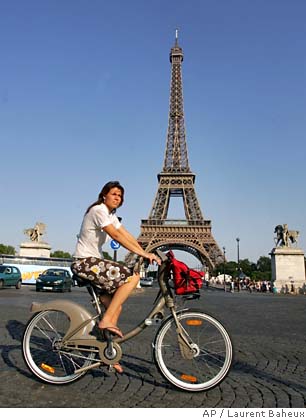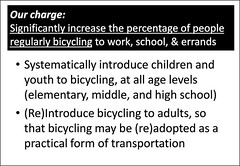Best practice bicycle planning for suburban settings using the "action planning" method
One of the frustrations I've had since I took on the job/project in Baltimore County is that there isn't a whole lot of what I would consider to be documents about best practices for promoting bicycling and walking and transit in the suburbs. Most of the writings and publicity about bicycling best practices are from the cities.

Velib bicycling at the Eiffel Tower, Paris. AP photo.
Casey Anderson, a Montgomery County bicycling advocate, suggested in February that my stint doing bicycle and pedestrian planning in the suburban context (Baltimore County) could result in some important insights.
At first, I responded in a blog entry that this was "Too much pressure" although that entry went on to outline the key issues:
1. Institutional/elected official commitment;
2. Agency commitment;
3. Financial commitment;
4. Having an extant "inventory" of space that can be made over into sidewalks and/or bicycle facilities;
5. Overall land use practices and spatial organization of the county to this point, which either support or do not support sustainable transportation;
6. Developing and providing encouragement systems to assist people in their adoption of walking and bicycling as a means of transportation;
7. Support, interest, and willingness not to mention advocacy for walking and bicycling improvements on the part of citizens.
Casey then invited me to join him on a panel to discuss suburban bicycle planning as part of the Rethink Montgomery lecture series, sponsored by the Planning Department of the Maryland National Capital Park and Planning Commission.
And having to come up with a presentation forced me to answer the question as best as I could. The presentation I made summarizes my sense of where suburban bicycle planning needs to focus in order to get "take up" of bicycling for transportation in significant numbers.
It extends my interpretation of best practice transformational planning, which I had previously discussed in this entry, "Social Marketing the Arlington (and Tower Hamlets and Baltimore) way," into an integrated framework that I am now calling "Action Planning."
Action planning takes the ideas of advocacy planning and marries to it the concept of action research to transform planning more towards being concerned about implementation and making things happen.
In a slide in the presentation (below) entitled "Action Planning as systems integration" I argue that Action Planning is a framework with five inter-connected components:
1. Design Method rather than Rational Planning
2. Social Marketing
3. Integrated Program Delivery System
4. Packaged through Branding & Identity Systems
5. Civic Engagement & Democracy at the foundation = citizen at the center
Three examples of government/government related programs that exemplify the approach are the transportation demand management programs in Arlington County, Virginia, as exemplified by their organization of the "WalkArlington," "Bike Arlington," and "FitArlington" programs, the repositioning of libraries in the Tower Hamlets borough of London as "Idea Stores," and the Live Baltimore resident attraction program in Baltimore City.
I argue that bicycle (and pedestrian and transit) planning more generally--whether or not in the suburbs as I made the same points about the city in my now three year old paper "Making Cycling Irresistible in DC"--needs to take this approach. Places like Arlington County and Portland, Oregon are executing this approach. Whether or not they call it "action planning," it's the approach that they are using.
Now I have to admit that the presentation below is edited after the fact. I added a couple slides and did a bunch of editing in response to having some reflection time after having initially "finished" making the presentation, the reaction, and the questions that came up afterwards.
Part of the problem with promoting bicycling as transportation, right now is that from the standpoint of innovation diffusion, bicycling in the United States is still at the very earliest stages of the innovation adoption curve, and the people who are the strongest proponents (a/k/a zealots) are often more focused on the purity of who and how people are involved and committed to bicycling, rather than being focused on how to get the 60% of the population that is willing to bicycle for transportation--but currently isn't bicycling--out from their cars and onto bicycles.
I argue that changing the bicycling (and walking and transit) paradigm requires four integrated steps:
1. Making the necessary Local (and state) Government policy, regulatory and organizational framework changes;
2. Complete route network and facilities;
3. Providing programming and support to help people take up bicycling (and walking and transit);
4. developing an implementation strategy and structure.
That's what the presentation is about.
One problem in my presentations is that I tend to link theory and practice into model frameworks, and most people aren't interested in the theory and overall framework, they just want to see results. But I argue that without a clear framework and theory, it's hard to be effective.
Comments on the presentation would be appreciated.Best practice bicycle planning for the suburbs

Labels: action planning, bicycling, car culture and automobility, transportation planning, urban design/placemaking, urban vs. suburban



0 Comments:
Post a Comment
<< Home